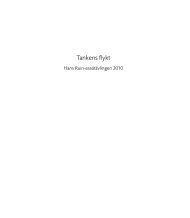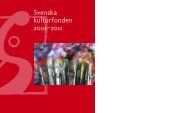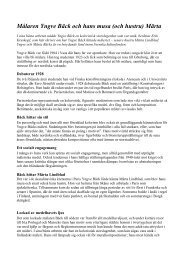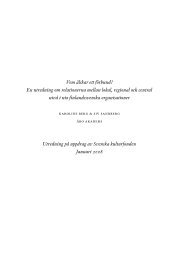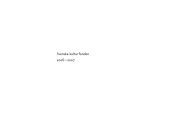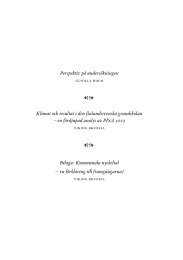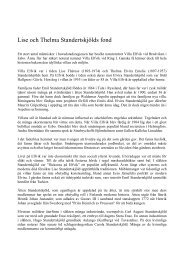Sesam - Svenska kulturfonden
Sesam - Svenska kulturfonden
Sesam - Svenska kulturfonden
Create successful ePaper yourself
Turn your PDF publications into a flip-book with our unique Google optimized e-Paper software.
Putting a twist on the working day<br />
Helena Björk<br />
A door is opened and a small world is put in<br />
motion. Pieces of landscape flow around inside<br />
a round water tank installed on the door. A<br />
mechanism ensures that the movement does not<br />
remain a mere implication thereof – rather, this<br />
is a dramatic convulsion in a miniature reality.<br />
What could be described as a picture mounted<br />
on a door, ostensibly without making any more<br />
substantial claims, conquers an existential<br />
moment in the working day at the office.<br />
Emma Rönnholm’s work is characterized by<br />
an inviting toying with everyday situations<br />
and materials. In the installation Days Gone<br />
By at Sinne in Helsinki in 2011, she presented<br />
free newspapers in a mobile arrangement<br />
that resembled a flying flock of birds. Passing<br />
families discovered the work and peeked<br />
inside the gallery – often at the initiative of<br />
the children. Everyday objects and motifs<br />
may enter the scene in other works as well. In<br />
them one may find the same playful attitude<br />
as with Gabriel Orozco, when he presses fluff<br />
from tumble driers to hard sheets, which<br />
are then mounted on a clothes line. In fact,<br />
Emma Rönnholm herself also has a certain<br />
predilection for laundry: her installation Full<br />
Moon (2011) was a staging of the mystical<br />
labyrinth made up by sheets drying on a clothes<br />
line. Part of her work In Due Time (2010) at the<br />
Finnish Academy of Fine Arts in turn consisted<br />
of a washing machine, the casing of which<br />
had been removed, so that the spectator could<br />
observe colorful bars of soap ground to powder<br />
by the tumbler. Places and materials that are<br />
often left unheeded are for her obvious entries<br />
into the world of imagination.<br />
An important feature of Emma Rönnholm’s<br />
work is to encounter the spectator in everyday<br />
life. She wishes to refine an unfeigned<br />
conceptual approach, where the means are not<br />
to be rendered convoluted. One thought is to<br />
discover ideas that could as easily originate in<br />
the imagination of the spectator in such a way<br />
that recognition of the content takes place – as<br />
if something suddenly materialized that one was<br />
thinking of while wandering around. Rönnholm<br />
is interested in reaching beyond representation:<br />
her artworks not only depict miniature worlds,<br />
but in fact are small worlds where things occur.<br />
A strong feel of the material is ever present in<br />
the works. This can be manifested in the form of<br />
interiors made of crisp bread or as a caravan of<br />
plastic vessels mounted on top of each other.<br />
In the offices of the Swedish Cultural Foundation<br />
in Finland, Emma Rönnholm has developed<br />
these ideas by creating a series of works for<br />
an everyday environment with personnel and<br />
frequent visitors. She has already for a long time<br />
wanted to create an artwork specifically for an<br />
everyday environment, with a more unexpected<br />
encounter with the spectator. You Rock My<br />
World (2012) constitutes of four works of art<br />
mounted on different doors. With these artworks<br />
Rönnholm has aspired to reach a whole, which<br />
according to her works both as a decorative<br />
element and as a slightly quirky comment on and<br />
witness of office life.<br />
The largest of the artwork carrying the title of<br />
the series has its point of origin in a sense of lost<br />
safety. The imagery is inspired by Elsa Beskow’s<br />
story Peter in Blueberry Land, where Peter is<br />
reduced in size by the magic of the King of<br />
Blueberry Land. This is the beginning of Peter’s<br />
adventure in the forest. The blueberries become<br />
large as apples, a leaf can be used as a sail and<br />
mice can be ridden on. The pieces, which<br />
constitute the landscape in Rönnholm’s work,<br />
depict elements familiar from the story: rocks,<br />
trees, blueberry twigs, mushrooms and different<br />
animals. They flow around in an easy poetic<br />
28 – 29<br />
movement; occasionally something sinks slower<br />
than the rest, helplessly as an object dropped<br />
in water. Occasionally a human form can be<br />
spotted in the commotion – a solid point for<br />
identification connected to the title of the work.<br />
On another office door there is a rotating disc<br />
full of doors in varied sizes. They are opened<br />
and shut according to the direction of the<br />
movement, revealing glimpses of other worlds.<br />
Behind most doors hazy landscapes emerge,<br />
but there are also occasional undefined<br />
interiors, which are suggestive of a corridor in<br />
a palace. The images bring dreams to mind.<br />
These entries to other worlds emerge to the<br />
sound of hatches composing an alluring<br />
rhythm. Concretely, the work mirrors the act<br />
of opening a door. In this way the piece also<br />
connects with the starting point of the works<br />
and reminds of what doors may represent.<br />
When a door is shut another is opened. New<br />
knowledge and new opportunities emerge.<br />
The diver is a figure within a smaller dome. The<br />
subject is chosen bearing in mind where the<br />
artwork is placed: it is on a door in the ladies’<br />
room and is thus is harder to discover than<br />
other works. Emma Rönnholm tells that she is<br />
fascinated by divers, who behind their masks and<br />
with all their gear appear entirely alien. In this<br />
work she has created a diver from hobby clay. He<br />
totes a next to comical crow’s nest of tubes on his<br />
back. This expresses a kinship with Rönnholm’s<br />
installation The Conspiracy (2011), in which she<br />
created a large-scale sculpture of electric wires.<br />
Now we are, however, dealing with something<br />
much smaller, something which requires an<br />
intimacy between the artwork and the spectator.<br />
The diver is in a dome that is mounted on sitting<br />
height, or the height of a small child’s eyes. The<br />
diver gets tipped over when the door is used and<br />
he has to find the balance anew each time. He<br />
embodies the idea behind all the works by being<br />
a mute presence, an observer or discoverer, who<br />
at the same time can be wavered at any given<br />
moment.<br />
Lastly, there is a lotto machine on the Director’s<br />
door. Colorful balls within a dome are set in<br />
motion when the door is opened. There is room<br />
for one new lotto line on a shelf.<br />
Emma Rönnholm toys with this work with<br />
the idea of the assignments of the Swedish<br />
Cultural Foundation in Finland. By being on<br />
the Director’s door, the artwork attests to the<br />
self-ironical faculty of the foundation. This is<br />
a highly postmodern notion, but not one of<br />
distancing along with it. It is also an expression<br />
for consciousness and self-reflection, which no<br />
actor in the contemporary art world can elude.<br />
Allocation of subsidies is – contrary to the lotto<br />
line – by no manner of means random, but it<br />
demands great diligence. Ease and happenstance<br />
is contrasted with responsibility in Rönnholm’s<br />
artwork. A positive notice of subsidy can sway<br />
an entire existence and bring along unexpected<br />
possibilities.




